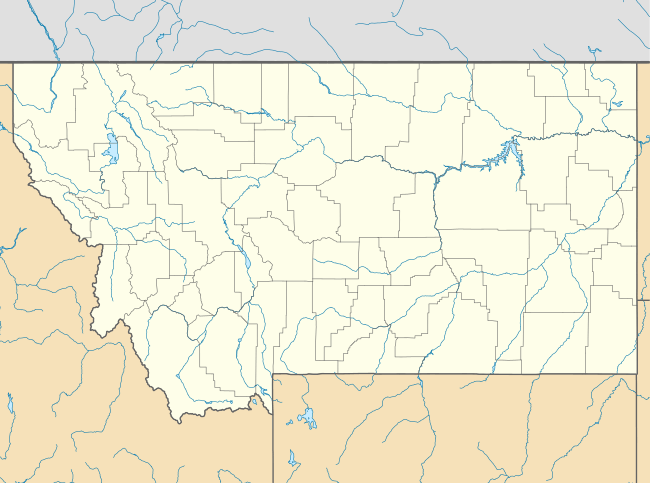St. Mary's Mission (Montana)
The Historic St. Mary's Mission is a mission established by the Society of Jesus of the Catholic Church; located now on 4th street in modern-day Stevensville, Montana. Founded in 1841 and designed as an ongoing village for Catholic Salish Indians, St. Mary's was the first permanent settlement made by European descendants in what became the state of Montana. The mission structure was rebuilt in 1866, with it being added to the National Register of Historic Places in 1970.[2]
St. Mary's Church and Pharmacy | |
 Side and rear of the church | |
  | |
| Location | North Ave., Stevensville, Montana |
|---|---|
| Coordinates | 46°30′29″N 114°5′43″W |
| Area | 2 acres (0.81 ha) |
| Built | 1866 |
| NRHP reference No. | 70000364[1] |
| Added to NRHP | October 6, 1970 |
The search for Black Robes
The Salish came to know about the Jesuits from Catholic Iroquois fur trappers who settled among them either in 1811[3]:22 or sometime after 1816.[4]:212 Especially Ignace (Big Ignace) aroused attention with his stories about the "Black Robes." Indian delegations reached St. Louis in 1831 and 1835, both in vain asking a priest to follow them back to the Salish country. Lakotas near Ash Hollow (Nebraska) killed a third group in 1837, including Ignace.[4]:213 Two Iroquois Indians met Father De Smet at Council Bluff in 1839 by chance, and in July 1840, he was greeted by more than 1,000 Salish and Pend d'Oreille Indians in Pierre's Hole.[5]:19–20 On September 24 the next year, he returned to the Salish.[5]:21 Accompanying him to the Bitterroot Valley were Fathers Gregory Mengarini and Nicholas Point as well as Brothers Joseph Specht, William Claessens and Charles Huett.[5]:21
The mission
Carpenter Brother Claessens led the building of the church.[5]:30 As construction began under the supervision of Pierre-Jean De Smet, he described St. Mary's and the Salish workforce as follows:
The women hewed down the timber, assisted by their husbands, with the greatest alacrity and expedition, and in a few weeks we had constructed a log church, capable of holding 900 persons. To ornament the interior, the women placed mats of a species long grass, which were hung on the roof and sides of the church, and spread over the floor,-- it was then adorned with festoons formed of branches of cedar and pine.[6]
Houses with lawns were built in harmony with Nicolas Point's plan, although it made the village open to attacks.[3]:114 A palisade shielded the church.[5]:22 The first communion was at Easter 1842.[3]:103 At this time, Chief Victor held the position as principal representative for the Bitterroot Salish.[5]:23 Father Anthony Ravalli joined the mission in 1845. He inoculated the Indians against smallpox and ran the dispensary.[5]:25 In 1846, the fields yielded 7,000 bushels of wheat and a considerable quantum of garden crops.[5]:25 However, by this time many Salish Indians slowly turned their backs to the mission and took up their former life. They felt betrayed with the establishment of a mission at Colville for their Blackfeet enemies.[3]:98 [5]:26
The mission is closed
Raids by Blackfeet Indians closed the mission in 1850.[5]:26 The abandoned church was burned, following the usual practice in such cases.[5]:26 The Jesuits sold the village to Trader John Owen for 250 dollars, although it actually was built on Salish land.[5]:26
The mission reopens
After sixteen years, St. Mary's mission started afresh in 1866. It was located a mile south of the first colony.[5]:28 The Catholic Salish attended sermons in the new church and later, settlers in the area would come as well.[5]:31 The church was enlarged in 1879.[5]:31 When Chief Charlo and the Bitterroot Valley Indians were moved to the other Salish already living in the Jocko Reservation in October 1891, it was the end of St. Mary's as an Indian mission.[5]:35
The mission complex today
The mission complex is open for tours from April through October. The buildings include the chapel with an attached residence, the infirmary, a dovecote, a cabin with Salish artifacts, and a visitor's center which contains a museum, research library, art gallery and gift shop.
References
- "National Register Information System". National Register of Historic Places. National Park Service. July 9, 2010.
- The Montana Catholic: St. Mary’s Mission in Stevensville designated National Historic District (September 17, 2010) Archived March 22, 2012, at the Wayback Machine
- Peterson, Jacqueline and Laura Peers (1993): Sacred Encounters. Father De Smet and the Indians of the Rocky Mountain West. Norman and London.
- Mellis, john C.: Ignace Partui: Iroquois Evangelist to the Salish, ca. 1780-1837. International Bulletin of Missionary Research. Vol. 33, No. 4 (Oct. 2009), pp. 212-215.
- Baumler, Ellen: A Cross in the Wilderness. St. Mary's Mission Celebrates 175 Years. Montana, The Magazine of Western History. Vol. 66, No. 1 (Spring 2016), pp. 18-38, sources pp. 92-93.
- Smet, Pierre. Origin, Progress, and Prospects of the Catholic Mission to the Rocky Mountains. Fairfield, Washington: Ye Origin Galleon Press, 1972. pp. 5-6.
External links
| Wikimedia Commons has media related to St. Mary's Mission (Montana). |
